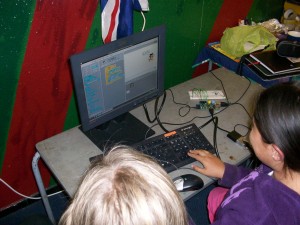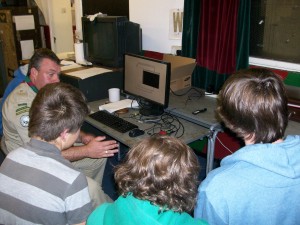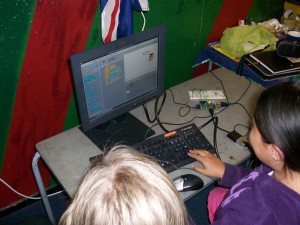Scouting is about trying new things, whether that is outdoors or indoors. This week we looked at the Raspberry Pi which is a computer about the size of a credit card. It was released a couple of years ago and has taken the world by storm since, with people all over the world making: robots, web servers, games machines, home cinema systems and even a super computer!
The Raspberry Pi was designed to boost the numbers of students studying computing, sadly, a lot of computing has disappeared from our educational system, these days programming and understanding computer architecture has completely disappeared from the Secondary education system and can only be found in AS-level or above–it has been replaced with learning about how to use software, not writing it!
At Scouts, we wanted to introduce the Raspberry Pi and let the Scouts get hands on with it. We are very fortunate as the Raspberry Pi foundation kindly supported us by donating a Pi for us to use. Another leader also bought their own Pi so we could split the Scouts into two groups and rotate them halfway through the evening.
We wanted to accomplish three things: first, to get the Scouts to understand the history of the Pi and the value it stands for; second, to introduce basic programming techniques in both Scratch and Python; third, to get the Scouts to use the GPIO ports to interface with the world and understand event driven programming.
To do this we split them into two groups as follows:
 The first group was introduced to Scratch, a fantastic programming language that uses coloured blocks as syntax. Each of the blocks is shaped differently depending on what order it can be used and where it can be placed. This allowed the Scouts (with very little tutoring) to start designing a program. They started by moving the character on screen around, getting it to ask questions and respond to certain answers.
The first group was introduced to Scratch, a fantastic programming language that uses coloured blocks as syntax. Each of the blocks is shaped differently depending on what order it can be used and where it can be placed. This allowed the Scouts (with very little tutoring) to start designing a program. They started by moving the character on screen around, getting it to ask questions and respond to certain answers.
 The second group was taught the basics of Python and how it can be used to control the GPIO ports and respond to events. They created several straight forward programs, one was an alarm system for their house or bedroom. It took an input from a switch (which could be a pressure switch or reed switch in real life), it then processed this signal and sounded the alarm. To stop the intruder from simply stopping the program to silence the alarm, the Scouts cleverly toggled the alarm so even if the Python script was stopped, the alarm would carry on sounding!
The second group was taught the basics of Python and how it can be used to control the GPIO ports and respond to events. They created several straight forward programs, one was an alarm system for their house or bedroom. It took an input from a switch (which could be a pressure switch or reed switch in real life), it then processed this signal and sounded the alarm. To stop the intruder from simply stopping the program to silence the alarm, the Scouts cleverly toggled the alarm so even if the Python script was stopped, the alarm would carry on sounding!
The evening was a great success and stood the Seniors on good ground to accomplish their Weather Balloon project next year. The Scouts picked up simple programming very quickly and soon made their own extensions to exercises we set them! This just proves that the Raspberry Pi aim of attracting young people into computing by creating a simple and straightforward platform they can learn on has been accomplished.
Not wishing to sound old but I am sure many adults reading this will remember the very first personal computers in the 1980s which only had a form of BASIC loaded on them. Writing in BASIC was not straightforward and took a long time to get excellent results. The Raspberry Pi on the other hand, accomplishes results with ease and makes the process fun – even for adults!

